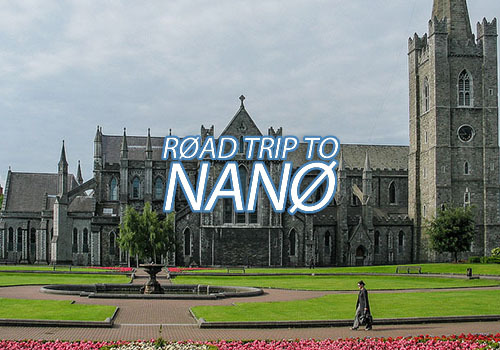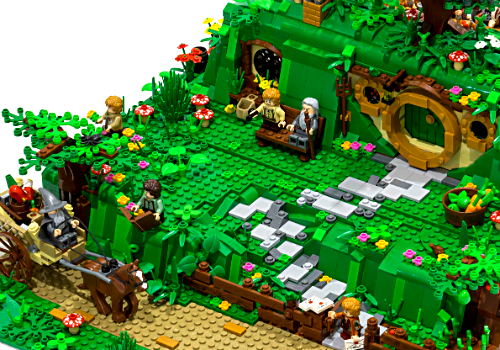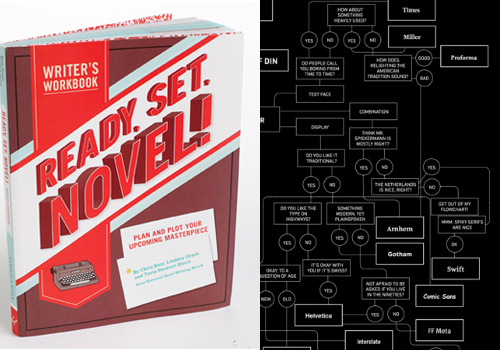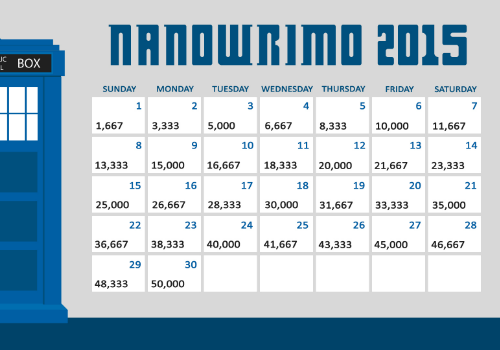Chris Baty's Blog, page 158
October 1, 2015
Road Trip to NaNo: How to Bring Life to Every Character

November is coming. To get ready, we’re taking a road trip starting in Dublin, Ireland, and winding our way back to Berkeley, CA. On the way, we’ll hear from Wrimos about how their cities can inspire your writing. Today, Dublin Municipal Liaison Ellen challenges you to look into every one of your characters’ stories!
Dublin is full of stories and storytellers. The city has a rich urban folklore all of its own—Dubliners still tell stories of a legendary 1950s cop, of fairies sighted in parks, and of the devil paying a visit to the Dublin Mountains.
When friends and families meet, the focus is on telling stories. Missing the bus can become an epic tale of struggle against adversity if you have the right audience and enough tea is flowing. There is an urban legend about every street, every pub, every larger-than-life character. In Dublin, everyone has a tale to tell…
Dublin has taught me that every character in a novel is caught up in their own story, whether or not the reader ever gets to know about it. The novelist chooses whose story to tell, but every character the protagonist meets has a novel of their own unfolding around them.
The main character’s sister might be desperate to get a place in university. She may be in love with the wrong person—or the right one. Does your main character’s mother or father hate their job? What would that mean for them—would it make them more ambitious, or less? Maybe your protagonist’s best friend arrives late in one scene; why? Where were they?
Of course, it isn’t possible to tell every character’s story. It is possible, though, to have a lot of fun, and write a richer novel—and boost your word count!—by knowing what other character’s back stories are, and using them to add colour to the world of your novel.
Think about books that you’ve read and how they might have been different if they had been about a different character. Imagine To Kill A Mockingbird from Jem’s or Miss Maudie’s point of view, or think about how the Eagle might have told the story of Looking for Alaska. What did they know that the main characters didn’t?
Now, take the time to flesh out the stories of the minor characters in your own novel-to-be. What secrets are they keeping? What do they know? What do they want? And how does all of this affect your main characters?

Ellen Brickley has been a NaNoWriMo ML for five years and a Dubliner for more than half of her life. She drinks too many chai lattes, takes too many photos, and reads too many books, but still thinks she has space for more. Her favourite thing to read and to write is YA fiction.
Top photo by Flickr user JMArmengod
September 30, 2015
Reaching 50,000: How to Shake Off Writer’s Fatigue

Like the main event itself, NaNo Prep is always better with an incredible writing community around you. Luckily, our forums come with such a ready-made community. Sujin Headrick, 13-time NaNoWriMo winner, shares her strategies for fighting past writer’s block with the Reaching 50,000 forum:
Whether this is your first NaNoWriMo or your fifteenth, one fact remains true: those who win NaNoWriMo are those who sit down and write. For the first few days, showing up to write every day is easy. The shiny factor hasn’t worn off yet, and the excitement over your story is almost palpable.
Then there are the other days, where the drive to write isn’t there. Adding words to your story feels like getting out of a warm, blanket-filled bed into a cold world: you don’t always want to do it, but it’s step one toward the journey ahead. Maybe you’ve written your characters into a corner with no ideas on getting them out. Or maybe you’re bored of your story but still have thousands of words to write before reaching the magical 50K, and the NaNo forums are singing their sweet song of procrastination…
Let’s answer that call and visit the Reaching 50,000 forum, where inspiration and motivation await you.
Don’t know what happens next?Take a trip through the Dares thread, a place for silly and occasionally outlandish dares to use in your novel. Some of last year’s included rubber ducks, food fights, and a time-traveling cat. Some of these dares can also work as plot ninjas, a plot interruption to toss into your story when you’re stuck. Actual ninjas are optional but encouraged.
Feeling ambitious? A few Wrimos have written NaNo-novels based entirely on dares from other participants.
Need to kill a character?The Traveling Shovel of Death lurks in the forum and in novels everywhere, hungry for blood and flesh. Its true origins are unknown but date back to sometime around 2005. Taking part in this NaNo tradition is easy: use a shovel to kill a character in your novel.
Once you’ve added a character to your novel’s body count, mourn their death in the Character Graveyard thread with other Wrimos and their deceased characters.
Need a character name?Include a subtle NaNoWriMo shoutout with Mr. Ian Woon, a NaNoWriMo anagram appearing in novels almost as long as NaNo has existed. That name doesn’t work, you say? Maybe your novel could use Iron Woman, Norma Owin, or a character eating a warm onion. These names work much better than Character A or That Lady With The Pet Monkey.
Does the magical goal of 50,000 feel so far away that you’re not sure you’ll make it?The Dirty Tricks thread is here to help. Really long chapter titles that detail everything in the chapter, or characters with long names, or omitting apostrophes so your characters always talk like this even if they are the type to use contractions find their homes here. Some of these tricks may truly be dirty, but if they get you closer to The End and keep you writing, then go for it.
You’re about to embark on the journey of your life, Wrimos. If you show up to write and keep making progress throughout the month, by November’s end you’ll have something most people don’t: a first draft. And that is worth celebrating.
Now get out there and get ready for November. I’ll see you in the winner’s circle.

Sujin Headrick is a 13-time NaNoWriMo winner, a feat that spans almost half her life. She is a NaNoWriMo Ambassador, @NaNoWordSprints leader, past Municipal Liaison, and founder of Is It NaNo Yet and Wikiwrimo. Her non-NaNo life (ha!) includes books, tea, math, and general geekery. Find Sujin at sushimustwrite.com or on Twitter at @sushimustwrite.
Top photo by Flickr user Eman Rus.
September 29, 2015
Worldbuilding: 3 Mottos to Fuel Your Creation

Like the main event itself, NaNo Prep is always better with an incredible writing community around you. Luckily, our forums come with such a ready-made community. We’ve asked Gwen Hicks, former intern, to scout out the Worldbuilding forum and report back with her findings:
Ah, worldbuilding. The breathtaking process of creating a place—a universe, a galaxy, a kingdom—all your own, concocting everything from languages to governments to geography to races to religions (and also probably dragons)… all for the express purpose of raining unmitigated destruction upon it by means of an epic, calamitous war!
Okay, I’m kidding. Worldbuilding can seem daunting at first—believe me, you’re looking at the Earth’s biggest worldbuilding-ophobe—but, really, be you planner or pantser, with a little Wrimo gumption, you’ll find it’s just as exciting as every other part of the whirlwind NaNo Prep process. And do you know what the best part is? After poking around the fantastic NaNo Worldbuilding forums, I’ve gathered three essential tips to get you started.
Look Outside.No matter how fantastical your fictional world is, the one around you is your greatest resource. Sure, it may not (provably) have dragons, but it’s made up of facets that are probably so natural to you that you’ve never even paid attention.
We fiction-writers can learn a lot from the Real World, because it’s mastered how to be one of the best things fiction can be: so naturally lived-in and breathing.
You’re Not Alone.Use the NaNo worldbuilding forum with abandon. It is chock full of writers just like you who are there for you to lean on and brainstorm with, and they are brilliant, and bursting with questions you hadn’t even thought to ask.
This thread
in particular—where you respond to a most recent poster’s worldbuilding thoughts, answer a question they’ve posed, and then ask one of your own—is already helping me! Some fantastic sample questions:
Don’t get so caught up worrying that your world is too similar to an already-existing one that you get discouraged. If it feels right for your story and your characters, then it probably is. Besides (and this is the NaNo mantra that has kept me going every year), you can always fine-tune it later. What matters now is the creation—the mad, beautiful creation—that drives all of us to shoot for that 50K in the first place.
It’s tough to impart “general wisdom” regarding worldbuilding, because maybe you’re inventing something—continents and history and all—completely from scratch, or maybe the maps you’re drawing will be star maps and Ganymede is a cultural melting pot, or maybe your backdrop is a modern-day Pompeii that was never devastated by a volcanic eruption.
These endeavors require three very different approaches, but the focal point should ideally be the same: shaping something— some streets, some forests, some wide open skies—so inviting, so organic, that you and your readers and your characters can’t imagine being anywhere else. That’s what made Hogwarts so nice, right? From the very beginning, it was home.
Just like NaNo is to me.
All right, gross. Moving on.

Gwen(dolyn) Hicks was the NaNoWriMo Editorial Intern for the 2014 NaNo season and is now working at Copperfield’s Books, wearing sweaters and caring too much about comic books. She tries to act cool and jaded but is actually very sensitive and emotional, especially about the song “Bye Bye Li’l Sebastian.” She aspires to learn witchcraft and also earn an MFA in fiction from someplace crazy enough to accept her. You can find her on Twitter and Tumblr.
Top photo by Flickr user S3ISOR.
September 28, 2015
Character Café: The Character-Creating Power of Reimagination

Like the main event itself, NaNo Prep is always better with an incredible writing community around you. Luckily, our forums come with such a ready-made community. We’ve asked Alicia Audrey, forums moderator, to share her best character creation and development tips, straight from the Character Café:
Creating characters can bring tremendous joy to the pre-writing and writing experience. One of my favorite ways to develop character is to exaggerate a known person.
The vibrant aunt, the saucy grandmother, the irritable boss, the perfect sibling: they all give us a lot of material for a running start. There are people in our lives who, with a nudge in a certain creative direction, could suit our story lines. It can be the greatest of pleasures to reimagine the people we encounter on a daily basis, amping them up with interesting characteristics and subplots and making them barely recognizable…
Whatever our methods, once characters are developed, we need to dive deeper into them. Sometimes, even though we create them, they only reveal parts of themselves on a need-to-know basis. That’s when we have to put on our hardcore writer gear and get serious. A tape recorder, notebook, and pen are completely necessary.
Interviewing characters has become relatively popular in recent character development discussion, but the landscape of this practice is wide and varied. The answers you get depend heavily on the way the questions are asked, the person asking them, and the perceived purpose. As in job interviews, use a variety of styles—group interviews, individual interviews, and situational questions. If you’re well-versed in the character interview, here are some techniques you can add to your bag of tricks:
Make them answer questions in the third person.
Interview them as:
The judge of a competitionAn ex
A lie detector test administrator
A speed dater
Force them to answer questions that seem to require background information with “yes” or “no” only. Describe their body language and thought process.
Ask them to describe characters they know well.
Ask them for first impressions of characters they don’t know.
Introduce them to situations and assess their behavior. How would they act:
at a 1980s dance partyat a religious ceremonyas the bearer of the worst possible newsif caught in a lieif they had to make an arrestif they were accused of something they didn’t doif they were in a room with people with radically opposing viewsif they were given an illegal substance
Travel back in time to when they were young.
Describe their visits from the ghosts of Christmas past, present, and future.
Ask them to write their own eulogy.
Using these exploratory techniques is sure to lead you to interesting discoveries. Be sure to inhabit the mind of your character as you respond to the questions and situations presented. The authenticity of voice will become apparent, and will color the pages of your novel-to-be.

Alicia Audrey is a writer, editor, blogger, and NaNoWriMo-enthusiast living and working in The Bahamas. She is the volunteer Municipal Liaison for her NaNoWriMo region, local writers’ group coordinator, and lover of flash fiction. She is addicted to milk chocolate, black tea, Coca-Cola, apple green, and snail mail. She can usually be found on Twitter as @_AliciaAudrey.
Top photo by Flickr user Stitch.
September 25, 2015
Plot Doctoring: How to Make Plotting Simple

Like the main event itself, NaNo Prep is always better with an incredible writing community around you. Luckily, our forums come with such a ready-made community. We’ve asked Letitia Jones, forums moderator, to talk to us about the Plot Doctoring forum, and how to construct a plot:
I envy pantsers, I really do. They can sit down, open their word processor or pick up a pencil, and the words will just flow out of them. No planning, no outline, and yet they manage to get it done. I’ve tried it and I ended up with a gargantuan knot of plot holes and twists the likes of which Stephen Hawking could attempt to untangle until the sun burned out.
I’m a planner like many of my fellow writers in the Plot Doctoring forum, and a rule of thumb I like to apply when plotting is that if it takes you longer to describe your plot than it does to send a text message you need to go back to the drawing board.
You know the saying, “Everything you need to know in life you learned in kindergarten”? Well, that principle can be applied even in plotting. You might have learned in kindergarten that simplicity is the key to success. Let’s take the simplicity route and see where we end up.
We are going to start with a simple sentence, free of characters, subplots, or twisty ends.
A boy meets a girl.
Nothing could get be simpler than that. A boy meets a girl. It’s a tale as old as time, and still as sweet as the first go-around. Now we are going to take this simple sentence and give it an equally simple resolution. Again, we don’t want anything flashy or fancy.
A boy meets a girl who changes his life forever.
Now we have a plot that will take us from the beginning of our story to the end.
Moving on, we’re going to add adjectives for the girl and the boy. An adjective is a describing word, which qualifies a noun or noun phrase, giving more information about the object signified.
A street rat boy meets a noble girl who changes his life forever.
Now, I know what you’re thinking: “We don’t have a villain yet!” So let’s go ahead and add in a villain. We are going to go through the same steps.
Simple sentence:
A wizard wants to rule the world.
A simple sentence with a resolution:
A wizard wants to rule the world by stealing a lamp.
A simple sentence with resolution and adjectives:
A bad wizard wants to rule the world by stealing a magical lamp.
Now let’s combine our initial sentence and the villain sentence with some flair.
A bad wizard wants to rule the world by stealing a magical lamp, but a street rat boy that meets a noble girl who changes his life forever thwarts him.
I know I know it doesn’t make a lot of sense and it’s a grammatical mess but the key here is simplicity. You want to keep you plot as simple and as basic as you can in the beginning as you start to write. This will allow you to create and destroy characters, subplots, and plot twists with abandon and with ease.
Plotting is not some mystical Holy Grail that you have to assemble the Fellowship or the Avengers to find. It’s as easy as a boy meets a girl.

Letitia Jones constructed her first story after she watched Michael Jackson zombie-walk across her screen and onto the page of her Lisa Frank notebook. She grew up in Germany. In 2010, she penned her first NaNo-novel while studying in Manchester, England. Since that first attempt, Tommeh has graduated from the University of North Carolina at Greensboro, moved back to Manchester and started a Creative Writing masters program at Manchester Metropolitan University. She is currently plotting her debut YA novel.
Top photo by Flickr user Tallent Show.
September 24, 2015
NaNo Prep: 4 Tips to Survive a Writing Marathon
Like the main event itself, NaNo Prep is always better with an incredible writing community around you. Luckily, our forums come with such a ready-made community. Today, we asked Briana Way, forums moderator, to talk to us about the NaNo Prep forum, and her best advice for November success:
It’s that season again. For me, autumn is here and that means leaves crunching under booted feet, the smell of pumpkin lattes, and time to start prepping for NaNoWriMo!
If you’ve participated in NaNoWriMo multiple times, you’ve probably got your style figured out. If it’s your first or second time—never fear! You are in for a lot of fun. The first thing you will want to do is figure out if you’re a planner or a pantser—there’s a list of distinguishing features on the NaNo Prep page.
If you’re a planner, well you’ve probably got a lot of your novel already fleshed out. If you’re a pantser, though, you might be wondering—how can I prepare?
Personally, I’m a wannabe planner, who always ends up becoming a pantser. Well, that’s a lie—I did manage to complete my second year as a planner. But the other four years I’ve participated, I’ve always ended up pantsing it. So, now I start with preparing in the following ways:
Schedule time to write. Even if you’ve set aside the whole month of November to write, there are still going to be real-life obligations that you have to deal with. Kids, work, school, bills—there are some things that just can’t be put aside.
Make sure to seek out some time that can be specifically set aside for writing. If you have any days you know you won’t be able to write, try to schedule time to make that up. Personally, my Tuesdays and Thursdays are very busy this semester—between the work that is due those days, I will be very stretched for time. I plan to set aside an extra two hours on Monday to boost my word count for those two days. This actually brings me to the next suggestion.
Practice writing. To write 50,000 words in 30 days, you’ll need to write 1,667 words a day. Learn how much time you need to make that 1,667 daily word-count goal.
In preparation just get yourself used to writing everyday or in spurts. (
My region, Rochester, occasionally posts prompts on their blog.) Practicing can also help get ideas flowing. If you have an idea already, then explore it; if you strengthen that idea, then the plot can follow once November starts.
As a pantser, you may want one or two alternative ideas ready in case that first idea doesn’t work out. Earlier, I said I was a wannabe planner. I always have that first idea planned out, but when I start writing it… well, I just get distracted by researching things I forgot about—like the poison my character is going to use in chapter five—when I’m not even done with chapter one. Usually, I just bail on the first idea and go with my second.
My final piece of advice, my fellow writers, is to stock up on writing fuel. Tea, coffee, chocolate, and snacks: anything to give you that spark of motivation to write those last few words. Truly, a well timed cup of tea, or a cookie can do wonders. Most importantly, have fun!

Briana is a senior Political Science and English double major at SUNY Geneseo. She likes to spend her free time reading or writing. Briana finished her first novel during her senior year of high school and has been writing ever since. After she graduates, Briana plans to pursue a career in law.
Top photo courtesy of nanocalendars2015!
September 23, 2015
Reference Desk: Everything You Need To Know To Write Your Novel, Realistically

Like the main event itself, NaNo Prep is always better with an incredible writing community around you. Luckily, our forums come with such a ready-made community. Today, we asked Lindsay Carlson, forums moderator, to talk to us about the Reference Desk forum, and how to begin your research now:
Coming up with the ideas is the easy part… creating authenticity requires work.
Are you searching for what caliber gun your ex-nun-turned-sniper would use in 1922 in the Australian Outback and what period-appropriate outfit she might don now that she’s no longer restricted to a black & white habit? Small details like these add color (literally) to your novel, and getting it “right” makes it easier for readers to immerse themselves in the world you create. So how do you get the details right?
Let’s talk research. Planners, you have less than two months to line up your primary, secondary, tertiary, quaternary, and so forth sources in an orderly manner according to your OCD tendencies (mine are alphabetically and by cover color).
People writing by the seat of your pants, don’t panic! If you’ve even got a smidge of an idea (say, an ex-nun turned sniper in 1920s Australia), you can easily grab some sources that may come in handy for a quick reference during November. Start by:
gathering relevant books, e-books, videos, seeking out helpful websites (Use Wikipedia but remember to double-check your facts later!), putting some people with firsthand experience on speed-dial, going to visit museums or locales you will use in your novel, taking copious notes on food, music, sounds, etc.—use all your senses in your writing!Now, back to your novel. I see you’ve got travel guides from 1920′s Australia checked out from the library & fashion plates from the 20′s Vogue webpage bookmarked and/or specific flapper outfits collated on Pinterest. A great start, but…
Let’s delve deeper. You know Ginger (the ex-nun/sniper) needs to hike up a mountain to see an old hermit about a prophecy. Your own mountain-scaling skills are maxed-out when you take the stairs to the third floor at the doctor’s office instead of the elevator, so “writing what you know” is out. Plus, Ginger needs to lug her sniper gun up there with her and you still have no idea what caliber it is. All your usual sources have struck out. Take a deep breath. All is not lost. Ask the Reference Desk!
Mods have made a spiffy list of Wrimos with expertise on a variety of unusual and interesting subjects whom you can ask for help. If they don’t know the answer, they can point you in the right direction toward other trust-worthy sources.
Once you’ve posted to the forum & collected personal anecdotes on mountain climbing, information on gun makes and models, and details about how to properly wear a flapper dress, things appear to be going quite well… until the plot bunnies escape. Barry, the prophesying hermit, tells Ginger she needs to use her new-found sniper skills to stop a pending intergalactic war over which star system makes the best kolaches…
*Throws up hands in defeat*
Kidding; don’t give up! If you cannot find the answer after consulting all your sources, it’s okay. Just remember, NaNoWriMo is for first drafts. Make a note in your novel—**Research mountain-dwelling prophesy hermits and best kolache recipes**—and come back to it later. You’ll have all the time in the world to get your details just right beginning in December.
Lindsay Carlson is a pharmacist who lives in Houston, TX. She is a member of Mystery Writers of America and a Municipal Liaison for the Houston area under the name CoffeeChick. She spends her free time consuming copious amounts of caffeinated beverages and building her wall of To-Read books while nurturing her growing fortune cookie addiction.
Top photo by Flickr user Manchester Library.
September 22, 2015
Adoption Society: Find Inspiration Here

Like the main event itself, NaNo Prep is always better with an incredible writing community around you. Luckily, our forums come with such a ready-made community. Today, we asked Casey Chwiecko, forums moderator, to talk to us about the Adoption Society forum, and how you can find inspiration in other writers:
Have you ever approached a November with increasing dread because you have no idea what to write? If you haven’t, I envy you. If you have, you are absolutely not alone.
We know that inspiration can be a fickle beast and everyone has a different way to tackle it. Some of us stare into the far distance with an all-knowing look until something smacks us in the face. Some of us run around in an utter panic asking everyone we know for an idea. Others will sit quietly and mine every conversation around them for plot bunnies. All of these are perfectly good ways to find ideas. If you’re desperate, though, we offer another alternative.
One year, I only knew I wanted to write something within my normal universe, but no idea what specifically. After some waffling, I went searching on the forums to see what I could see and discovered the Adoption Society forum.
I dove into the long standing and truly wonderful “Adopt a Plot” thread and came out knowing I wanted to write about an assassin. Although my exact plot wasn’t among the suggested ones in that thread, reading through everyone’s plot ideas brought the necessary “Aha!” moment. From there, I could figure out why my assassins existed, who they were and how they meshed (or didn’t) with my original cast.
All of us have the tendency to hit a writing brick wall sometimes and that’s when two heads are better than one; the Adoption Society is ready to help out.
A particular recurring favorite is the lovely “Adopt a Torture” thread (be warned: it can get gruesome!). It is exactly what it says on the label. If you’ve found a juicy way to pick on a character, we want to hear it. No, seriously, please tell us. Someone else might want to do the same, or modify it. (Modifying it might sometimes be the best part, but don’t take my word for it). We certainly won’t think less of you. Quite the opposite in fact.
Maybe you can’t exactly find what you’re looking for in the Adoption Society, and that’s okay too. Use that New Thread button and ask away. Take a good mix from multiple threads, mash them together and see what comes of it. Bet you might just be amazed at how well things turn out when you pull inspiration from your fellow writers. After all, no one person could shepherd all these plot bunnies.

Casey Chwiecko is a two-time volunteer Municipal Liaison—on two continents—and a longtime moderator on the forums. She’s a teen librarian just outside Boston. This will be her twelfth year of doing NaNo. She enjoys reading, going on adventures, and snuggling dogs. She also used to work as a cruise ship librarian and spent a NaNo bouncing around the Caribbean. She does not take herself too seriously.
Top photo by Flickr user Daquella manera.
September 21, 2015
Appellation Station: The Complex Art of Naming Your Characters

We’re neck-deep in NaNo Prep season. Like the main event itself, NaNo Prep is always better with an incredible writing community around you. Luckily, the NaNo Tips & Strategies forums have a ready-made community. Today, we asked Tia Kalla, forums moderator, to talk to us about the Appellation Station forum, and the complex art of naming your characters:
So you’re working on developing your characters, but you’re not really sure where to start? (Like answering rhetorical questions?)
Names are often one of the first things I nail down about a new character: partly because I help moderate the Appellation Station forum, partly because “Hey, you” gets confusing after a while, and partly because the mere act of assigning a name can help decide certain things for your character.
Like what, you ask? (Am I rocking these rhetorical questions or what?) Well…
GenderSure, there are traditionally female names and male names. But there are also gender-ambiguous names and names that skew one way or another. Readers and characters alike form impressions based on those names, and it can be fun to defy those impressions by giving a character an unexpected name. (My 2013 NaNo included a girl with a masculine-sounding name—which accidentally gets her a roommate assignment with a boy. Whoops!)
AgeEver heard of someone named Ethel or Mary and expected them to be old? How about expecting a Madison or Alexis to be younger? Certain names were so popular at various points of history that you can date a character by their name alone sometimes.
At least in the US, , which can give you a place to start.
Cultural backgroundOne of my pet peeves is seeing someone ask for a throwaway or cameo name, and get nothing but Jessicas, Sarahs and Emilys.
One of the easiest ways to get variety in a story is to just think outside the box. Why not go for a Yumi, or a Semiha, or a Taye? If you’re just starting with a character, giving them a culturally unique name can be a great jumping off point for development—after all, a Svetlana is not likely to have the same life experiences as a Sally!
GenreThere must be something about fantasy names that we can identify them by their feel alone (and I don’t think it’s just the apostrophes!) Otherwise, why would we have many dedicated to them?
Likewise, sci-fi and alien names have a feel to them, trending toward short and punchy while fantasy tends to skew more lyrical. And of course, if you’re writing historical fiction, your names will represent your niche in history.
Their Destiny!But no, really. A lot of authors like to give their characters names that contain meaning, which may be significant to the story or just to the reader.
For example, Usagi Tsukino from Sailor Moon means “rabbit of the moon”, a reference to the Japanese myth of a rabbit on the moon and the fact that she’s the moon’s princess.
Beorn, a character in The Hobbit, whose name means “bear spirit”, was a bear skinchanger. Other writers may name characters after people they know, or inside jokes—like, I hear there’s a bunch of people that name a character “Mr. Ian Woon”…
So, does this give you some food for thought on what work your character’s name can do for you? Or are you just tired of the rhetorical questions?
…I’ll show myself out now.

Former volunteer Municipal Liasion for NaNoWriMo, current moderator, and participant for probably longer than the recommended exposure, Tia Kalla is a fan of lengthy subordinate clauses and the Oxford comma. She writes all over the genre map, but mostly fantasy, and makes too many cannibal jokes. Someone dared her to put “a thing” in her bio, so she did.
Top photo by Flickr user bump.
September 18, 2015
Ready, Set, Novel!: Building a Conflict Flowchart

It’s officially #NaNoPrep season! Inspired by the creativity and motivational prompts in Ready, Set, Novel!—written by our own Chris Baty, Lindsay Grant, and Tavia Stewart-Streit—we’re bringing some of our favorite writing exercises to you. Today, we’re asking “What if?”:
Life has conflicts, so it only makes sense that your novel would have conflicts, too. Not all conflicts have to life-changing or dramatic; something as simple as not being able to find an outfit for the day can be stress-inducing and climactic.
Remember, conflicts often lead to new conflicts. Think about your favorite novel, then break down the plot into separate conflicts:
In The Hunger Games, Katniss’ conflict at first is that she wants to protect her younger sister. The two of them really only have each other to rely on, and, for the first time, her sister is eligible for the Hunger Games, a competition in which teenagers fight to the death.
When her sister’s name is called, Katniss “resolves” this initial conflict by volunteering in her sister’s place, leading to a new conflict: learning what it takes to survive the Hunger Games.
The first step? To prove she’s a worthy competitor so that she can receive the sponsor support that is crucially needed to survive these Games. She resolves this conflict with her training scores, but that brings up another conflict: to survive with a target on her back as a front-runner. She resolves this conflict by teaming up with another competitor in the Games, Rue. We’re not even halfway through the book yet (and haven’t included the subplot conflicts with Peeta!), and we’ve got a whole bundle of conflict that flows naturally from the resolution of previous conflict.
Take one of your favorite books, then map out the conflict flow of the main character.
Then, start with the seed of your main character’s conflict? What do they want? From there, draw out the conflict flow—what happens when they get what they want? Is it what they thought it would be? Does it lead to more danger? In novels, even more so than in life, we have to be careful what we wish for…
Top photo by Flickr user caseorganic.
Chris Baty's Blog
- Chris Baty's profile
- 63 followers




